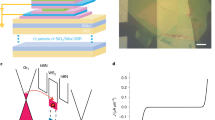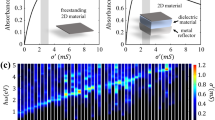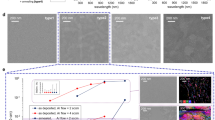Abstract
The optical properties of transition metal dichalcogenides (TMDs) are known to change dramatically with doping near their excitonic resonances. However, little is known about the effect of doping on the optical properties of TMDs at wavelengths far from these resonances, where the material is transparent and therefore could be leveraged in photonic circuits. We demonstrate the strong electrorefractive response of monolayer tungsten disulfide (WS2) at near-infrared wavelengths (deep in the transparency regime) by integrating it on silicon nitride photonic structures to enhance the light–matter interaction with the monolayer. We show that the doping-induced phase change relative to the change in absorption (|∆n/∆k|) is ~125, which is significantly higher than the |∆n/∆k| observed in materials commonly employed for silicon photonic modulators, including Si and III–V on Si, while accompanied by negligible insertion loss.
This is a preview of subscription content, access via your institution
Access options
Access Nature and 54 other Nature Portfolio journals
Get Nature+, our best-value online-access subscription
$29.99 / 30 days
cancel any time
Subscribe to this journal
Receive 12 print issues and online access
$209.00 per year
only $17.42 per issue
Buy this article
- Purchase on Springer Link
- Instant access to full article PDF
Prices may be subject to local taxes which are calculated during checkout






Similar content being viewed by others
Data availability
The experimental dataset and its analysis is provided in the paper and any additional datasets that support the plots within this paper and other findings of this study are available from the corresponding author upon reasonable request.
References
Bonaccorso, F., Sun, Z., Hasan, T. & Ferrari, A. C. Graphene photonics and optoelectronics. Nat. Photon. 4, 611–622 (2010).
Wang, Q. H., Kalantar-Zadeh, K., Kis, A., Coleman, J. N. & Strano, M. S. Electronics and optoelectronics of two-dimensional transition metal dichalcogenides. Nat. Nanotechnol. 7, 699–712 (2012).
Santos, E. J. G. & Kaxiras, E. Electrically driven tuning of the dielectric constant in MoS2 layers. ACS Nano 7, 10741–10746 (2013).
Xia, F., Wang, H., Xiao, D., Dubey, M. & Ramasubramaniam, A. Two-dimensional material nanophotonics. Nat. Photon. 8, 899–907 (2014).
Ross, J. S. et al. Electrically tunable excitonic light-emitting diodes based on monolayer WSe2 p–n junctions. Nat. Nanotechnol. 9, 268–272 (2014).
Jariwala, D., Sangwan, V. K., Lauhon, L. J., Marks, T. J. & Hersam, M. C. Emerging device applications for semiconducting two-dimensional transition metal dichalcogenides. ACS Nano 8, 1102–1120 (2014).
Schwarz, S. et al. Two-dimensional metal–chalcogenide films in tunable optical microcavities. Nano Lett. 14, 7003–7008 (2014).
Ferrari, A. C. et al. Science and technology roadmap for graphene, related two-dimensional crystals, and hybrid systems. Nanoscale 7, 4598–4810 (2015).
Pospischil, A. & Mueller, T. Optoelectronic devices based on atomically thin transition metal dichalcogenides. Appl. Sci. 6, 78 (2016).
Mak, K. F. & Shan, J. Photonics and optoelectronics of 2D semiconductor transition metal dichalcogenides. Nat. Photon. 10, 216–226 (2016).
Xiao, J., Zhao, M., Wang, Y. & Zhang, X. Excitons in atomically thin 2D semiconductors and their applications. Nanophotonics 6, 1309–1328 (2017).
Manzeli, S., Ovchinnikov, D., Pasquier, D., Yazyev, O. V. & Kis, A. 2D transition metal dichalcogenides. Nat. Rev. Mater. 2, 17033 (2017).
Bernardi, M., Ataca, C., Palummo, M. & Grossman, J. C. Optical and electronic properties of two-dimensional layered materials. Nanophotonics 6, 479–493 (2016).
Bie, Y.-Q. et al. A MoTe2-based light-emitting diode and photodetector for silicon photonic integrated circuits. Nat. Nanotechnol. 12, 1124–1129 (2017).
Basov, D. N., Averitt, R. D. & Hsieh, D. Towards properties on demand in quantum materials. Nat. Mater. 16, 1077–1088 (2017).
Romagnoli, M. et al. Graphene-based integrated photonics for next-generation datacom and telecom. Nat. Rev. Mater. 3, 392–414 (2018).
Woessner, A. et al. Electrical 2π phase control of infrared light in a 350 nm footprint using graphene plasmons. Nat. Photon. 11, 421–424 (2017).
Ding, Y. et al. Effective electro-optical modulation with high extinction ratio by a graphene–silicon microring resonator. Nano Lett. 15, 4393–4400 (2015).
Sorianello, V. et al. Graphene–silicon phase modulators with gigahertz bandwidth. Nat. Photon. 12, 40–44 (2018).
Phare, C. T., Lee, Y.-H. D., Cardenas, J. & Lipson, M. Graphene electro-optic modulator with 30 GHz bandwidth. Nat. Photon. 9, 511–514 (2015).
Ross, J. S. et al. Electrical control of neutral and charged excitons in a monolayer semiconductor. Nat. Commun. 4, 1474 (2013).
Chernikov, A. et al. Electrical tuning of exciton binding energies in monolayer WS2. Phys. Rev. Lett. 115, 126802 (2015).
Wang, G. et al. Colloquium: excitons in atomically thin transition metal dichalcogenides. Rev. Mod. Phys. 90, 021001 (2018).
Mak, K. F. et al. Tightly bound trions in monolayer MoS2. Nat. Mater. 12, 207–211 (2013).
Yu, Y. et al. Giant gating tunability of optical refractive index in transition metal dichalcogenide monolayers. Nano Lett. 17, 3613–3618 (2017).
Doylend, J. K. et al. Two-dimensional free-space beam steering with an optical phased array on silicon-on-insulator. Opt. Express 19, 21595–21604 (2011).
Sun, J., Timurdogan, E., Yaacobi, A., Hosseini, E. S. & Watts, M. R. Large-scale nanophotonic phased array. Nature 493, 195–199 (2013).
Shen, Y. et al. Deep learning with coherent nanophotonic circuits. Nat. Photon. 11, 441–446 (2017).
Kang, K. et al. High-mobility three-atom-thick semiconducting films with wafer-scale homogeneity. Nature 520, 656–660 (2015).
Braga, D., Gutiérrez Lezama, I., Berger, H. & Morpurgo, A. F. Quantitative determination of the band gap of WS2 with ambipolar ionic liquid-gated transistors. Nano Lett. 12, 5218–5223 (2012).
Li, Y. et al. Measurement of the optical dielectric function of monolayer transition-metal dichalcogenides: MoS2, MoSe2, WS2, and WSe2. Phys. Rev. B 90, 205422 (2014).
Mlack, J. T. et al. Transfer of monolayer TMD WS2 and Raman study of substrate effects. Sci. Rep. 7, 43037 (2017).
Akiyama, S. et al. 12.5-Gb/s operation with 0.29-V cm V πL using silicon Mach–Zehnder modulator based-on forward-biased pin diode. Opt. Express 20, 2911–2923 (2012).
Liu, A. et al. A high-speed silicon optical modulator based on a metal–oxide–semiconductor capacitor. Nature 427, 615–618 (2004).
Marris-Morini, D. et al. Low loss and high speed silicon optical modulator based on a lateral carrier depletion structure. Opt. Express 16, 334–339 (2008).
Xiao, X. et al. High-speed, low-loss silicon Mach–Zehnder modulators with doping optimization. Opt. Express 21, 4116–4125 (2013).
Soref, R. & Bennett, B. Electrooptical effects in silicon. IEEE J. Quantum Electron. 23, 123–129 (1987).
Jin, Z., Li, X., Mullen, J. T. & Kim, K. W. Intrinsic transport properties of electrons and holes in monolayer transition-metal dichalcogenides. Phys. Rev. B 90, 045422 (2014).
Rasmussen, F. A. & Thygesen, K. S. Computational 2D materials database: electronic structure of transition-metal dichalcogenides and oxides. J. Phys. Chem. C 119, 13169–13183 (2015).
Wang, C. et al. Integrated lithium niobate electro-optic modulators operating at CMOS-compatible voltages. Nature 562, 101–104 (2018).
Wang, C., Zhang, M., Stern, B., Lipson, M. & Lončar, M. Nanophotonic lithium niobate electro-optic modulators. Opt. Express 26, 1547–1555 (2018).
Harris, N. C. et al. Efficient, compact and low loss thermo-optic phase shifter in silicon. Opt. Express 22, 10487–10493 (2014).
Masood, A. et al. Fabrication and characterization of CMOS-compatible integrated tungsten heaters for thermo-optic tuning in silicon photonics devices. Opt. Mater. Express 4, 1383–1388 (2014).
Miller, S. A. et al. Large-scale optical phased array using a low-power multi-pass silicon photonic platform. Optica 7, 3–6 (2020).
Timurdogan, E., Poulton, C. V., Byrd, M. J. & Watts, M. R. Electric field-induced second-order nonlinear optical effects in silicon waveguides. Nat. Photon. 11, 200–206 (2017).
Kieninger, C. et al. Ultra-high electro-optic activity demonstrated in a silicon–organic hybrid modulator. Optica 5, 739–748 (2018).
Elías, A. L. et al. Controlled synthesis and transfer of large-area WS2 sheets: from single layer to few layers. ACS Nano 7, 5235–5242 (2013).
McCreary, K. M., Hanbicki, A. T., Jernigan, G. G., Culbertson, J. C. & Jonker, B. T. Synthesis of large-area WS2 monolayers with exceptional photoluminescence. Sci. Rep. 6, 19159 (2016).
Lee, J. et al. Crack-release transfer method of wafer-scale grown graphene onto large-area substrates. ACS Appl. Mater. Interfaces 6, 12588–12593 (2014).
Han, J.-H. et al. Efficient low-loss InGaAsP/Si hybrid MOS optical modulator. Nat. Photon. 11, 486–490 (2017).
Acknowledgements
Research on tunable optical phenomena in TMD semiconductors was supported as part of the Energy Frontier Research Center on Programmable Quantum Materials funded by the US Department of Energy (DOE), Office of Science, Basic Energy Sciences (BES), under award no. DE-SC0019443. Research by I.D. on TMD films for ultrafast and low-power applications was funded by the Defense Advanced Research Projects Agency (DARPA) award nos. HR001110720034 and FA8650-16-7643 and the Air Force Office of Scientific Research (AFOSR) MURI award no. FA9550-18-1-0379. Integration of TMDs with Si photonics for data communications was funded by the Office of Naval Research (ONR) award no. N00014-16-1-2219 and National Aeronautics and Space Administration (NASA) grant no. NNX16AD16G. C.P. and J.P. acknowledge funding from AFOSR (FA9550-16-1-0031 and FA9550-16-1-0347). Y.Y. and L.C. acknowledge support from an EFRI award from NSF (EFMA 1741693). S.H.C. was supported by the Postdoctoral Research Program of Sungkyunkwan University (2016). This work was done in part at the City University of New York Advanced Science Research Center NanoFabrication Facility, in part at the Cornell Nanoscale Facility, supported by NSF award no. EECS-1542081 and in part at the Columbia Nano Initiative (CNI) shared labs at Columbia University in the City of New York. We thank A. Mohanty, C.T. Phare, S.A. Miller and U.D. Dave for fruitful discussions.
Author information
Authors and Affiliations
Contributions
I.D. and M.L. conceived and proposed the TMD-based photonic design and experiments. S.H.C., J.H. and D.N.B. proposed the use of WS2 for these photonic structures. C.P. and J.P. provided the MOCVD WS2 film for the ionic liquid experiments, Y.Y. and L.C. provided the CVD WS2 and MoS2 film for the capacitive device experiments, and S.H.C. and B.L. performed the TMD transferring and characterization (photoluminescence measurements). I.D. fabricated the composite photonic device, with assistance from S.H.C. for TMD processing and development, G.R.B. for ITO development and M.A.T. for the SU-8 cladding of the composite structures. I.D. performed and analysed the optical measurements of the photonic devices. I.D. and G.R.B. performed the capacitance measurements of these structures. I.D. and M.L. prepared the manuscript. S.H.C., D.N.B., J.H. and M.L. edited the manuscript. J.H. and M.L. supervised the project.
Corresponding author
Ethics declarations
Competing interests
M.L., J.H., I.D., S.C., G.R.B. and D.N.B are named inventors on US provisional patent application 16/282,013 regarding the technology reported in this article.
Additional information
Publisher’s note Springer Nature remains neutral with regard to jurisdictional claims in published maps and institutional affiliations.
Supplementary information
Supplementary Information
Supplementary Sections 1–15 and Figs. 1–17.
Rights and permissions
About this article
Cite this article
Datta, I., Chae, S.H., Bhatt, G.R. et al. Low-loss composite photonic platform based on 2D semiconductor monolayers. Nat. Photonics 14, 256–262 (2020). https://doi.org/10.1038/s41566-020-0590-4
Received:
Accepted:
Published:
Issue Date:
DOI: https://doi.org/10.1038/s41566-020-0590-4
This article is cited by
-
Monolithic back-end-of-line integration of phase change materials into foundry-manufactured silicon photonics
Nature Communications (2024)
-
Wandering principal optical axes in van der Waals triclinic materials
Nature Communications (2024)
-
A Purcell-enabled monolayer semiconductor free-space optical modulator
Nature Photonics (2023)
-
Ultrathin quantum light source with van der Waals NbOCl2 crystal
Nature (2023)
-
Ultra-compact nonvolatile phase shifter based on electrically reprogrammable transparent phase change materials
PhotoniX (2022)



